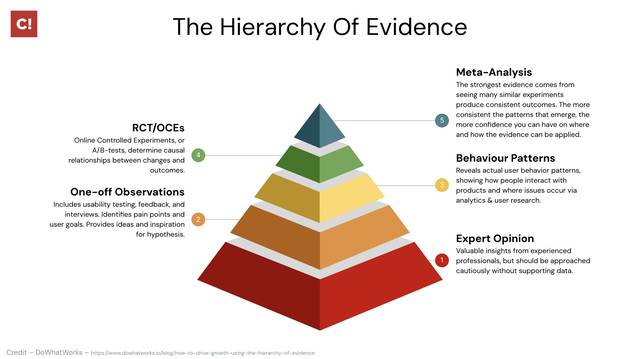
As there is a food pyramid outlining the different nutritional values of food, there is a similar one for research called the Hierarchy of Evidence. There are many different takes on it, and in the past year, Erin Weigel included a version of it in her book "Design For Impact" (which is also a great book that you should definitely check out!). Later, DoWhatWorks also iterated on this concept. These adaptations resonated very well with us at Conversionista, as they align closely with our own approach to UX research and experimentation. Expert opinions (like ours, and those of other designers and product managers) are at the bottom – they're the research equivalent of snacks. Experience matters, but as the pyramid shows, most opinions are biased. They're tasty and can provide quick energy, but you wouldn't want to base your entire diet on them.
As we move up the pyramid, we find more systematic and rigorous methods. One-off observations, like usability tests and customer feedback, are like your first serving of vegetables. They point to pain points and give ideas, but they need to be validated in action.
Systematic user research, often combined with quantitative data sources, comes next in our evidence hierarchy. This approach is like keeping a detailed food diary while also tracking your vital signs. It reveals behavior patterns and UX opportunities through multiple, complementary data points. For instance, we might pair in-depth user interviews with analytics data to get a fuller picture. It's more comprehensive than one-off observations, giving us a richer understanding of user needs and pain points. However, while this method is more informative, it still doesn't definitively prove causality.
At Conversionista, we place great emphasis on Randomized Controlled Trials, or more specifically Online Controlled Experiments (A/B tests) – they're the protein-packed main course of our research diet. Sitting near the top of our evidence pyramid, these experiments are the gold standard for proving causality. They don't just suggest what might work; they definitively show what does work (and what doesn't) in your digital product. By randomly assigning users to different versions of your site or app, we can isolate the impact of specific changes. This method allows us to draw rock-solid, data-driven conclusions about what truly drives user behavior and conversions. It's why we rely so heavily on these experiments – they provide the most nutritious, substantial evidence to fuel your digital growth strategy.

Credit - Do What Works
You might have heard the popular notion that testing with just 5 users is enough. This idea stems from a 1993 study – practically prehistoric in internet years. It's like basing your nutrition on a 30-year-old fad diet that promised miraculous results with minimal effort. While it was groundbreaking for its time, it's been widely misunderstood. The study focused on finding common usability issues cost-effectively, not uncovering all potential problems.
Think of it like this: a quick snack might get you through a busy workday, but it's not a complete nutritional plan. Similarly, testing with 5 users can uncover obvious issues, but it's just an appetizer in the feast of user research.
However, the digital world has evolved dramatically since then. Newer (but still old) studies from 2001, 2003, and beyond have thoroughly debunked this oversimplified approach. They reveal that to truly drive growth and gain comprehensive insights, you need a full-course research meal served regularly and in a variety of ways.
Modern UX research recognizes that user behavior is complex and constantly changing. We need more robust, ongoing research methods that capture a wider range of user experiences and scenarios to keep up. It's not about finding a magic number of users, but about creating a consistent, diverse research practice that evolves with your product and your users.
Asking how much research is enough, is like asking how many vegetables you should eat. It depends on your overall diet. What other data are you already collecting? What decisions do you need to make? The key is to have a balanced approach that provides consistent, actionable insights.
Doing user research once every few years is like eating vegetables on your birthday and expecting to be healthy. It just doesn't work that way. Yes, some research is better than none – it's like sneaking a single carrot stick into your diet. But let's aim higher, shall we? To truly understand your users and drive growth, you need a consistent diet of insights. A robust research strategy is like a colorful salad – diverse, nutritious, and satisfying. Regular research helps you stay in tune with evolving user needs and market trends.
User research has an expiration date just like that forgotten cucumber in the back of your fridge. How long it stays fresh depends on the type of research, much like how different veggies have different shelf lives. A usability study might stay relevant for a few months, while a deep dive into user motivations could provide insights for a year or more. The key is to keep your research fresh and ongoing.
Relying on just one type of research is like eating only tomatoes. Sure, they're great, but you're missing out on a whole spectrum of nutrients—or, in our case, insights. Mix it up with usability testing, surveys, interviews, and analytics. Each method brings something unique, helping you build a well-rounded understanding of your users.
User research isn't a one-time thing or a quick fix. It's an ongoing commitment to understanding your users and driving data-informed growth. So, let's treat it like the essential nutrient it is. Make user research a regular part of your digital diet, mix up your methods, and watch your conversions grow healthier by the day.
Remember, at Conversionista, we're here to help you craft that perfect research menu. Let's make your digital presence thrive with a healthy dose of user insights!
Ready to accelerate your digital growth? Add your details here or email us at hej[a]conversionista.se and we’ll get back to you.
